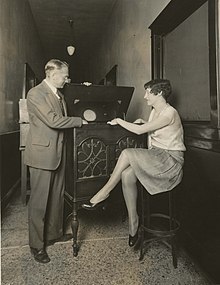Vladimir Zworykin
| Cyrillic ( Russian ) | |
|---|---|
| Влади́мир Козьми́ч Зворы́кин | |
| Transl. : | Vladimir Koz'mič Zvorykin |
| Transcr. : | Vladimir Kosmich Sworykin |
Vladimir Kosma Zworykin (originally Russian Владимир Козьмич Зворыкин Vladimir Kosmitsch Zvorykin ; born July 17 . Jul / 29. July 1888 greg. In Murom , Russian Empire ; † 29. July 1982 in Princeton , New Jersey ) was a Russian-American engineer , Physicist and inventor .
life and work
Vladimir Zworykin studied at the University of Saint Petersburg from 1906 to 1912 . He was a student of the television pioneer Boris Rosings . From 1912 to 1914 he continued his studies in Paris, at the Collège de France , under the direction of Paul Langevin . During the First World War he served in the telecommunications force, after which he worked in the officers' radio school in St. Petersburg, then known as Petrograd. After the October Revolution of 1917, he fled to Omsk , at that time the center of the anti-Bolshevik movement in Siberia, where he was busy building radio stations. In 1919, during a business trip to New York, the anti-Bolshevik movement in Siberia was finally crushed, so there was no way back home. In the USA he became an employee of the Westinghouse Electric Corporation . He patented the Ikonoskop tube in 1923 . The iconoscope is the first useful device for electronically scanning images and breaking them down into electrical signals. Its prototype was not realized by Zworykin until 1933, at a time when his competitor Farnsworth had already built this tube and used it in a camera (first in 1926). However, in 1929 Zworykin invented the kinescope tube for the electronic reproduction of these images, making it one of the fathers of modern electronic television . Today's picture tubes practically correspond to Zworykin's kinescope.
Zworykin was also involved in the development of color television and the electron microscope (1942).
The IEEE awarded from 1952 to 1986 one named after Zworykin award for outstanding technical developments in the field Television.
membership
In 1941 Zworykin was elected to the American Academy of Arts and Sciences , in 1943 to the National Academy of Sciences and in 1948 to the American Philosophical Society . Since 1931 he was a fellow of the American Physical Society .
Publications
- VK Zworykin, Earl DeWitt Wilson: Photocells and their Application. J. Wiley & Sons, New York 1930.
- VK Zworykin, George A. Morton: Television; the Electronics of Image Transmission. J. Wiley & Sons, New York 1940.
- VK Zworykin, ED Wilson: Photoelectricity and its application. J. Wiley & Sons, New York 1949.
- VK Zworykin u. a .: Electron Optics and the Electron Microscope. J. Wiley & Sons, New York 1945.
- VK Zworykin: Some Prospects in the Field of Electronics. Washington 1952.
- UK Zworykin: Como evoluciona la televisión. Madrid 1954.
- VK Zworykin, GA Morton: Television; the Electronics of Image Transmission in Color and Monochrome. J. Wiley & Sons, New York 1954.
- VK Zworykin, EG Ramberg, LE Flory: Television in Science and Industry. J. Wiley & Sons, New York 1958.
literature
- Albert Abramson: Zworykin, Pioneer of Television . Champaign, Illinois 1995, ISBN 0-252-02104-5 .
- Vasilij Borisov: Vladimir Koz'mič Zvorykin, 1889–1982 . Moscow 2002, ISBN 5-02-022727-7 .
Web links
Individual evidence
- ^ IEEE page on the IEEE Vladimir Zworykin Award ( English, visited on May 7, 2008 )
- ↑ Book of Members 1780 – present, Chapter Z. (PDF; 117 kB) In: American Academy of Arts and Sciences (amacad.org). Accessed February 5, 2018 .
- ↑ Member History: Vladimir Kosma Zworykin. American Philosophical Society, accessed November 17, 2018 .
| personal data | |
|---|---|
| SURNAME | Zworykin, Vladimir |
| ALTERNATIVE NAMES | Sworykin, Vladimir Kosmich; Zvorykin, Vladimir Kozʹmič; Зворыкин, Владимир Козьмич (Russian) |
| BRIEF DESCRIPTION | Russian-American engineer, physicist and inventor |
| DATE OF BIRTH | July 29, 1888 |
| PLACE OF BIRTH | Murom , Russian Empire |
| DATE OF DEATH | July 29, 1982 |
| Place of death | Princeton , New Jersey |

